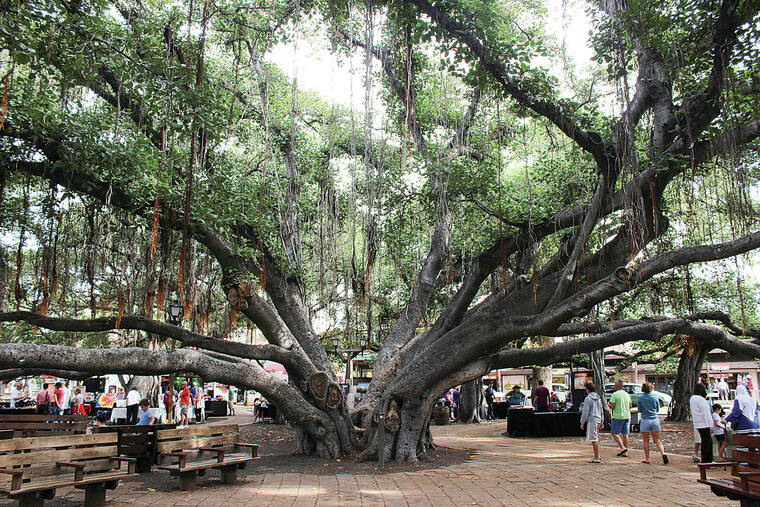Resilient 150-Year-Old Banyan Tree Bounces Back from Devastating Wildfire

Resilient 150-Year-Old Banyan Tree Bounces Back from Devastating Wildfire
In a remarkable display of nature’s tenacity and a testament to the enduring bond between nations, a 150-year-old banyan tree, gifted by India to the United States in 1873, has defied the odds by sprouting new leaves after being charred in a devastating wildfire that swept through Maui, Hawaii. The tree, standing tall at 60 feet, not only survived the inferno but has begun a vibrant revival, casting a beacon of hope in the aftermath of the tragic wildfire that claimed the lives of 97 people.
The story of this venerable banyan tree is one of resilience and the enduring friendship between two nations. Back in the late 19th century, this magnificent tree was sent across the oceans from India as a symbol of goodwill and friendship. Over the years, it grew into the largest of its kind in the United States, becoming a cherished part of Maui’s natural heritage. Its sprawling canopy provided shade and sanctuary to countless visitors and locals, making it an iconic and beloved landmark.
However, disaster struck when wildfires, fueled by dry conditions and high winds, raged through Maui, leaving destruction in their wake. The ancient banyan tree, with its extensive canopy, became a vulnerable target for the relentless flames. The tree’s trunk bore the scars of the fire, and its once lush canopy was reduced to a charred skeleton.
The aftermath of the wildfire left the community of Maui heartbroken, mourning the loss of lives and the devastation of their natural surroundings. But amidst the ashes and despair, a symbol of hope emerged as the banyan tree began to demonstrate an astonishing resurgence. New green leaves sprouted from the seemingly lifeless branches, a vivid testament to the resilience of nature.

Local residents and visitors alike were awestruck by this miraculous rebirth, which quickly became a symbol of hope and recovery for the community. Many began to gather around the tree, witnessing firsthand the remarkable transformation taking place. It was as though the tree itself was sending a message of hope, declaring that even in the face of adversity, life finds a way.
The revival of the banyan tree has also garnered attention from scientists and conservationists who are eager to study the mechanisms behind this incredible recovery. They are examining the tree’s ability to regenerate and adapt to extreme conditions, seeking insights that could be applied to the preservation of other endangered species and ecosystems.
Local authorities have taken measures to protect and support the tree’s recovery, implementing a watering and fertilization plan to ensure its continued growth. Additionally, the tree has been cordoned off to prevent any harm or disturbance, allowing it to flourish undisturbed.
The enduring significance of this tree transcends its physical presence. It stands as a symbol of the enduring friendship between India and the United States, a bond that has spanned over a century and a half. The tree’s survival and resurgence serve as a powerful metaphor for the resilience of nations in the face of adversity.
:max_bytes(150000):strip_icc():focal(749x0:751x2)/lahaina-banyan-tree-post-fire-081723-1ac42896f83946c18997a8d9a5262db4.jpg)
In a statement, the Indian Ambassador to the United States expressed his delight at the news of the banyan tree’s revival, saying, “This tree has not only weathered the storm but has emerged stronger, symbolizing the enduring friendship between our two great nations.”
The local community of Maui has also rallied around the banyan tree, organizing events and gatherings to celebrate its remarkable recovery. It has become a symbol of hope and a focal point for healing in the wake of the devastating wildfire.
As the world watches in wonder at the banyan tree’s resurgence, it serves as a reminder that even in the darkest of times, nature has the power to rejuvenate and renew. This resilient tree, gifted by India and cherished by the people of Maui, stands as a living testament to the indomitable spirit of life itself. It is a symbol of hope, recovery, and the enduring bonds of friendship that unite nations across time and distance.
The story of the 150-year-old banyan tree’s resurgence continues to captivate people not only in Maui but around the world. Social media has played a significant role in spreading the news, with images and videos of the tree’s green revival going viral. Messages of support and admiration have poured in from individuals, environmentalists, and leaders, emphasizing the universal appeal of nature’s ability to rebound against all odds.
The banyan tree’s newfound vitality also sparks conversations about the importance of preserving and protecting our natural heritage. In an era when climate change and environmental degradation pose significant challenges, the tree’s remarkable recovery serves as a stark reminder of the need for conservation efforts. It highlights the potential for ecosystems to bounce back when given the opportunity and resources.
Scientists are closely monitoring the banyan tree’s recovery, hoping to uncover valuable insights that could inform strategies for restoring damaged ecosystems worldwide. The tree’s adaptability and resilience offer hope for the restoration of other fire-ravaged landscapes and habitats, fostering a sense of optimism among conservationists and environmentalists.
While the banyan tree’s recovery is a beacon of hope, it also underscores the urgency of addressing climate change and mitigating the risk of wildfires in vulnerable regions. As communities come together to celebrate this extraordinary story of revival, they are also reminded of the responsibility to protect and preserve our natural world. The banyan tree, once charred and seemingly lifeless, now stands as a living testament to the power of nature and the enduring spirit of cooperation between nations in the face of adversity.
The rejuvenation of the 150-year-old banyan tree has also sparked discussions on the importance of wildfire prevention and management. While the tree’s remarkable resilience is cause for celebration, it serves as a stark reminder of the destructive potential of wildfires. Communities in wildfire-prone areas are now reconsidering their strategies for prevention and emergency response, aiming to reduce the risk to both human lives and natural treasures like the Maui banyan tree.
Local environmental organizations have seized this opportunity to raise awareness about the vital role that trees and forests play in mitigating climate change. Trees are not only essential for providing oxygen and absorbing carbon dioxide but also for stabilizing soil, conserving water, and supporting biodiversity. The banyan tree’s revival serves as a compelling example of the broader significance of trees in maintaining the ecological balance and safeguarding our planet’s future.

As the news of the tree’s resurgence continues to resonate, it has inspired acts of kindness and unity within the community. Residents and visitors alike have come together to contribute to the tree’s care and support its continued growth. This collective effort reflects the human capacity to find hope and healing in the face of adversity, a lesson that extends beyond the natural world.
In conclusion, the story of the 150-year-old banyan tree’s remarkable recovery is more than just a tale of nature’s resilience; it is a symbol of hope, unity, and the enduring connection between nations. Its revival has reminded us of the urgent need to protect our natural heritage, prevent wildfires, and address climate change. This living testament to the power of nature continues to inspire individuals and communities to work together to create a brighter, more sustainable future for our planet.




